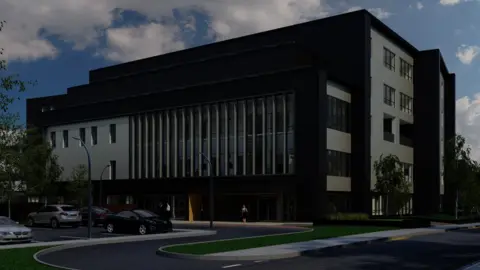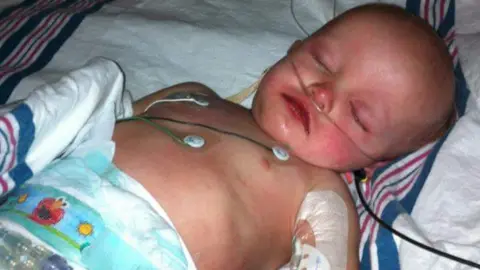Proton beam cancer treatment to start in Manchester in 2018
 Christie Hospital NHS Foundation Trust
Christie Hospital NHS Foundation TrustThe first high-energy proton beam therapy centre run by the NHS is soon to open at the Christie Hospital in Manchester, allowing patients in the UK to access an important treatment for life-threatening cancers.
Proton beam therapy is a highly advanced way of treating cancers without damaging tissues around the tumours.
Currently, NHS patients who need this treatment had to travel abroad but after years of planning, the multi-million pound project is entering its final stages and patients should be able to access the new treatment from August 2018.
In the week before Christmas, builders were busy fixing cladding to the outside of what will eventually be a smart new building alongside one of the UK's leading centres for the treatment of cancer.
But it is inside, where medicine and physics meet, in the form of the high-energy proton beam, that a new cancer treatment will be offered.
New options for treatment
Paediatric cancer consultant Dr Ed Smith has been at the heart of the Christie project to bring the first treatment of this kind to an NHS hospital.
He is excited at the possibilities the new therapy opens up.
"Young patients would benefit most from this treatment because their tissues are growing and are very sensitive to radiation.
"But there are also tumours that sometimes sit next to quite critical structures in the body, say at the base of the skull or around the spine.
"And this technology enables us to give a treatment dose to those patients while avoiding these critical structures," he said.
It has been a huge undertaking, involving years of planning, preparation and fundraising and backed up by £250m of UK government money, to fund two centres, in Manchester and at London's University College Hospital.
How does proton beam therapy work?
With standard radiotherapy, a beam travels through the tumour, but can damage sensitive tissues in front, behind and around it.
But a proton beam is much smaller and stops at the tumour, causing less damage to otherwise healthy tissue.
The protons - which come from the heart of an atom - are generated in a particle accelerator known as a cyclotron.
Travelling at a speed of 100,000 miles per second, equivalent to two-thirds the speed of light, they are directed with pinpoint accuracy at the tumour.
 Science Photo Library
Science Photo LibraryA low-energy form of proton beam therapy is available in the UK at the Clatterbridge Cancer Centre in the Wirral, where it is used to treat rare cancers of the eye.
But the new machine in Manchester is the first in an NHS hospital capable of delivering much higher doses to a broader range of cancers.
Some private clinics in the UK are also planning on offering the therapy.
Travelling for treatment
Up until now, the NHS has been sending patients who needed proton beam therapy to clinics in Switzerland or the USA.
Lucas Rothwell, now aged seven, travelled to the US with his family in December 2011 when he was diagnosed with cancer as a small baby.
But the journey almost killed him.
 Jodie Rothwell
Jodie RothwellWith an immune system weakened by chemotherapy, Lucas fell seriously ill with septicaemia, meningitis and pneumonia.
On Christmas Eve, the hospital advised his parents that Lucas might not pull through and they should call a priest to administer the last rites.
Lucas made it through the night and went on to eventually get the treatment he so badly needed.
'Really difficult'
But his Mum, Jodie, says that, even without the added trauma of his illness, the experience was a real challenge for the family.
"Just being there on your own, it's a lot to be going through.
"Just dealing with the cancer, you need your family and friends around you, you need people to talk to."
I asked Jodie how hard it was to be away from her support network of friends and family.
"You're there for six weeks but we were there for 10 and we found it really, really difficult.
"Not being at home, being around strangers, it was awful."
Six years on and Lucas is cancer-free and full of beans.
The Manchester centre will be opening later this year and the centre in London will follow in 2020.
